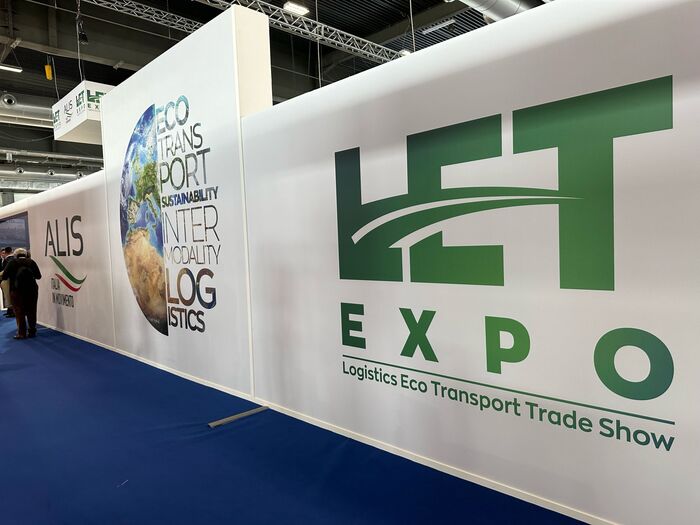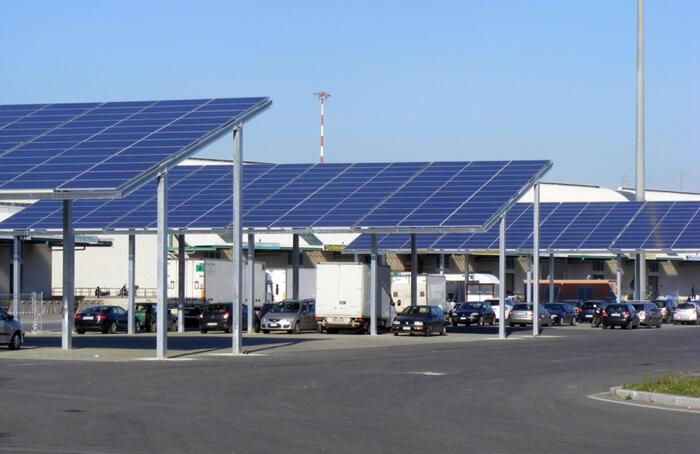Imagine any object, food or product that you use in your daily life: a pen, the computer in the office, your partner's favorite coffee, the fruit for breakfast or the book on the bedside table... These things - and even more such as medical supplies—have something in common: they have traveled hundreds of kilometers from their point of production, they have made a stopover at one or two distribution centers (or
hub
as the Anglo-Saxons call them) and have been delivered by a parcel service so that you can enjoy it wherever you want.
This entire complex, and sometimes invisible, framework (which brings together packaging, shipping, storage and transportation) has been put to the test over the last two years, not only by the pandemic but also by the rise of electronic commerce.
It has gained prominence in the economy.
In 2021, the logistics sector in Spain moved around 725 million shipments, which is 6% more than in 2020 and a historical figure, according to estimates by UNO, the employer's association.
"If before supply chain management basically had the sole objective of reducing costs, now its greatest value lies in guaranteeing sales," says Francisco Aranda, a representative of the organization.
The speed of reaction in the delivery has been truffled with the shortage of supplies, the problems in the maritime trade, the lack of drivers and the increase in energy and fuel.
This cocktail has put the members of this gear under stress and while some companies are experiencing a moment of glory, others are going through a bumpy road.
At the top of the arena is the logistics real estate sector (inmologistics).
Last year it received a flood of money: nearly 2,200 million euros, 54% more than in 2020, the highest figure this segment has ever received, according to data from the CBRE consultancy.
Much of that mana comes from Bankinter.
The financial firm has acquired a platform (which includes 22 assets, equivalent to a gross surface area of 865,000 square metres, plus 13 projects under development) for which it paid around 1,000 million euros, according to market sources.
The appetite for this business is unstoppable.
The hiring of warehouses and distribution platforms soared in 2021 by 44% to reach more than 2.7 million square meters.
Madrid (with one million square meters for rent) and Barcelona (with about 750.
000) are the areas with the most demand.
Behind: Zaragoza, Malaga, Bilbao and Seville.
“The growth of electronic commerce has changed the interest of investors and tenants in this market”, highlights Alberto Larrazábal, national director of Industrial & Logistics at CBRE.
"Logistics has not stopped," adds Massimo Marsili, General Manager of XPO Logistics for Southern Europe and Morocco.
This giant, a logistics partner of Inditex, has spread throughout the Peninsula, where it has more than 60 centers that have allowed it to grow up to 70% in its large last-mile business.
“We have more than 4,500 daily deliveries of this product… We are leaders in
pallets
.
We can move more than 20,000″, he points out.
One of its enclaves is just 30 minutes from Madrid, in Illescas (Toledo), where the success of the sector can be felt.
In this land with only 30,000 inhabitants, Zalando, DHL, H&M, Seur, Airbus, Dia, Toyota, Michelin, Correos Express… and many more companies have found fertile soil to grow their warehouses.
The location of this municipality makes it unique: 25 kilometers from the capital and connected to all the radial motorways in Spain.
Amazon moved here in 2017 and last year built a huge warehouse.
organized disorder
Within the 180,000 square meters of surface area occupied by the technological giant's new warehouse in Illescas, robots and humans work in unison.
When a person clicks on the purchase button, from their computer or mobile, the signature algorithm starts up and gives the order to one of the 2,895 robotic vehicles that moves one of the 53,160 shelves, all full of products that they have no relationship.
They call it "organized disorder", because in the same compartment there can be a notebook, a razor, a pacifier, a mobile phone case... and hundreds of other references that an operator chooses as indicated by the system.
Everything works like clockwork there.
Robot carriers (AGV: Automatic Guided Vehicle) never collide with each other.
They have a rhythm: one stops to give way to another,
Amazon already has more than 40 centers in Spain.
They come in all sizes: from department stores to last-mile centers.
And they are spread throughout the Spanish territory, but the most important are near (or inside) the big cities: Madrid, Barcelona, Seville, Murcia.
In the Community of Madrid, it recently opened two more: one in Móstoles and another in Coslada, dedicated exclusively to the same-day delivery service.
"Madrid is the city with the largest population in Spain and also with the highest consumer demand," says Víctor Romía, regional director of Customer Fulfillment for Amazon in Spain.
The e-commerce boom is pushing hard.
Today, 76% of Spanish Internet users between the ages of 16 and 70 (25.8 million people) shop regularly online, according to IAB Spain.
In 2019, the figure was 71%.
Parcel companies have felt the uptick.
"We have had to adapt in a flexible way to a variable demand depending on the situation", highlights Roberto Pascual, general director of DHL Supply Chain Iberia.
"In the last 18 months our crossing and storage capacity has grown by more than 50%", explains Belén Arrazola, Director of Organization and Systems of the MRW Group.
In this company, in the two years of the pandemic, B2B (the relationship between manufacturers and subcontractors) has remained stable, while electronic commerce has had continued growth.
"We have practically reached a balance between B2B and B2C [sale to the final consumer]", adds Arrazola.
“Those who are already consuming
online
they are increasing the frequency of purchase or the average price”, says Estela Ye, director for Spain of AliExpress, which belongs to the Asian giant Alibaba.
The company jumped into the Spanish market in 2019 and since then has seen the business flourish at a good pace.
"Spain is the third most important market for AliExpress [behind Russia and the US], in terms of gross merchandise volume, among all the countries and regions where we sell," said the representative of the company, which also has seven physical stores in Spain and an online food sales business (Lola Market).
Through collaboration with different operators, it has three logistics warehouses and a parcel classification center (19,000 square meters) on the outskirts of Madrid, in San Fernando de Henares.
The enclave that the company has chosen is not fortuitous.
It is in the Corredor del Henares: a logistics node between Azuqueca de Henares (Guadalajara), Coslada (Madrid) and San Fernando de Henares (Madrid).
"It is the golden mile of the sector", emphasizes Laly Escudero, president of the Association of Entrepreneurs of Henares (AEDHE).
Some 2,000 companies that store and distribute any type of product coexist there.
Its position is unique: it is connected to the Barajas airport (about five minutes away) and less than half an hour from the center of Madrid.
There is also a railway terminal (called a dry port), with a customs service and where maritime containers are received from the four most important ports in the country: Valencia, Algeciras, Barcelona and Bilbao.
logistics hub
, boosting the air transport business that has resumed flight after having fallen by 26.3% in 2020.
Chance
Freight traffic by plane was close to reaching the values prior to 2019, the best year in the historical series.
"93.4% of the cargo has been recovered," says Tomás Vázquez, head of Aena's Air Cargo Development Division.
It is advancing at a good pace and in better health compared to passenger traffic, which has not yet reached half the pre-pandemic level (43.6%).
Airlines have seen an opportunity to make up for what was lost in 2020 and have jumped in to respond quickly to demand.
“We are capable of connecting any destination in the world, Asia with Latin America, or vice versa, in 48 hours”, says Fernando Terol, director of IAG Cargo in Spain.
"We have converted three [Iberia] passenger planes into fully freighters, which allows us to carry goods in the cabin and in the holds," adds Terol.
Loading of an Iberia plane at the Adolfo Suárez Madrid-Barajas airport. Víctor Sainz
Until 2019, half of the goods that moved through the air went on a cargo plane.
The other half did it in the holds of passenger aircraft.
With the plummeting of the trips, the frequencies were reduced and with them the prices shot up.
“Today we have cargo capacity in warehouses that is approximately 25% below pre-pandemic levels, and with much higher prices per kilo,” says Jesús Sánchez, General Manager of Hubs & Gateways at DHL Express. Spain.
This company has its own fleet, but also operates with other airlines.
Before the covid, I paid to send a package from Madrid to Asia, on a commercial airline, one euro per kilo.
Now pay three euros.
From Madrid to the US, the cost went from 1.50 euros in 2019 to an average of 3.5 euros in 2021.
"At specific times we have paid up to seven euros," says Sánchez.
The attractiveness of this business is such that Correos, together with Iberojet, has everything ready to enter this market.
jam in the sea
Air cargo has collapsed due to the traffic jam in maritime transport.
This last activity is controlled almost entirely by four large shipping companies, which has accumulated not only delays in delivery (only 35% of ships worldwide reach their destination on time, according to Sea-Intelligence), but also an increase in prices.
Taking something by ship, for example from the port of Shanghai to the port of Rotterdam, was 55% more expensive last January than a year ago;
in April 2021, the price was already 441%, according to the Drewry World Container Index.
Although the traffic jam has focused mainly on the United States and China, the lack of space and the increase in costs have been felt in Spanish ports.
“The logistics of the loading companies have been stressed to the maximum to continue offering good levels of service.
The proof is the famous shortage of supplies that was talked about so much at the end of 2021 and that has not arrived, and of which we had seen very harsh images in the United Kingdom, ”says Jordi Espín, general secretary of the Association of Loading Companies (Transprime ), main clients of the shipping companies.
"Except in specific cases, there were no traffic jams in Spanish ports," says Álvaro Rodríguez Dapena, president of the Ports of Spain.
Excess capacity – which was generated decades ago and involved some gargantuan investments – has been key to dealing with this crisis.
"It has become an advantage, fundamentally, in the southern Mediterranean", details the representative of this organization, which brings together 46 ports of general interest, managed by 28 Port Authorities.
Currently, port capacity is between 60% and 70%.
"That means that from time to time we can have a vessel on standby and from then on it is inadmissible... We will probably have to generate a little more buffer of overcapacity," he warns.
And for this, by 2025 investments of around 11,000 million euros are planned, of which 4.
750 million will come from public coffers and the rest will come from private sources.
The bet is that the cargo continues to recover, after having fallen in 2020. At the end of 2021, it was around 545 million tons throughout the network, according to estimates by the Ports of Spain, very close to the 564 million tons of the year prior to covid-19.
This link is essential for the movement of goods.
60% of exports and 85% of imports pass through Spanish ports.
The large container ships usually dock at the port of Algeciras, for example, and from there the cargo is distributed on smaller ships that later go to other terminals in the country.
Once the products make landfall, the next step is to distribute them: by road or rail.
And this is where the chain starts to get tangled.
Both sectors have suffered from the increase in the price of energy and fuel, which in maritime transport has been resolved by reducing the speed of navigation.
The solution, however, is difficult to emulate in other sectors.
For road freight transport companies (through which 95% of the goods pass),
In 2021, the average price of diesel increased by 30%, according to the European Union (EU) Oil Bulletin.
Fuel hasn't been that expensive since the end of February 2013. And that has taken its toll on a fragmented sector (five out of ten truck drivers are self-employed who operate a single vehicle).
Now the price of gas has also skyrocketed.
"The companies that decided to convert their fleets to this energy are experiencing a real hell," says José María Quijano, of the Spanish Confederation of Freight Transport (CETM).
The cost of fuel has been equated to that of personnel.
Today, on average, they account for two thirds of operating costs, says Ramón Valdivia, general director of the International Road Transport Association.
“Energy has gone up, tolls have gone up,
trucks have risen... Those costs can no longer be absorbed... Among the entire logistics chain, road transport has the smallest margins and the greatest competition,” complains Quijano.
Benjamín Calzón, director of Excellence in Operations at Seur, says that operators not only face the increase in fuels, but also electricity, wood for pallets, plastic... All of this has an impact on the final consumer.
"Obviously, we have to transfer the prices to the client and he will have to transfer them, in the part that he considers, to the final customer."
He says that operators not only face the increase in fuels, but also electricity, wood for pallets, plastic... All this has an impact on the final consumer.
"Obviously, we have to transfer the prices to the client and he will have to transfer them, in the part that he considers, to the final customer."
He says that operators not only face the increase in fuels, but also electricity, wood for pallets, plastic... All this has an impact on the final consumer.
"Obviously, we have to transfer the prices to the client and he will have to transfer them, in the part that he considers, to the final customer."
queuing on trains
"The train is the oxygen of the ports and the ports are the sap of the railway... They are a marriage that should last," says Fernando González Laxe, former president of Puertos del Estado.
But it's not like that.
That intermodality that exists in other EU countries in Spain is almost anecdotal.
The country, as far as the movement of goods by rail is concerned, is in the last positions of the EU, with a rate of 4% transported by this mode, compared to the community average of 18%.
The Government's plan (as established in the Merchandise Plan 30) is to bring this percentage, before 2030, up to 10%.
To this end, it foresees investments of more than 8,000 million in infrastructure, digitization and an aid plan for companies.
But given the rise in costs, private entrepreneurs demand more support.
"Efforts to save the sector are insufficient," emphasizes Juan Diego Pedrero, president of the Association of Private Railway Companies.
"The price of energy has had increases of up to 400% and its impact on total costs is leading us to collapse," he stressed.
The global number of tons transported by rail has decreased since the start of liberalization.
Since the almost 30 million tons that were transported in 2006 and, after passing the pothole of the 2010 crisis, which placed it at around 21 million tons, that level has not been reached again.
"The problem is that the train has not been able to compete with road transport," says Eduard Albors, an expert in mobility and transport.
"The sector in Spain is very fragmented and adapts to market conditions, the environment and the situation, being very competitive in prices," they point out from Renfe Mercancías, through an email.
This has led to a stagnation of cargo and fierce competition between the public company and private firms.
Today, Renfe Mercancías has a share of 59%.









